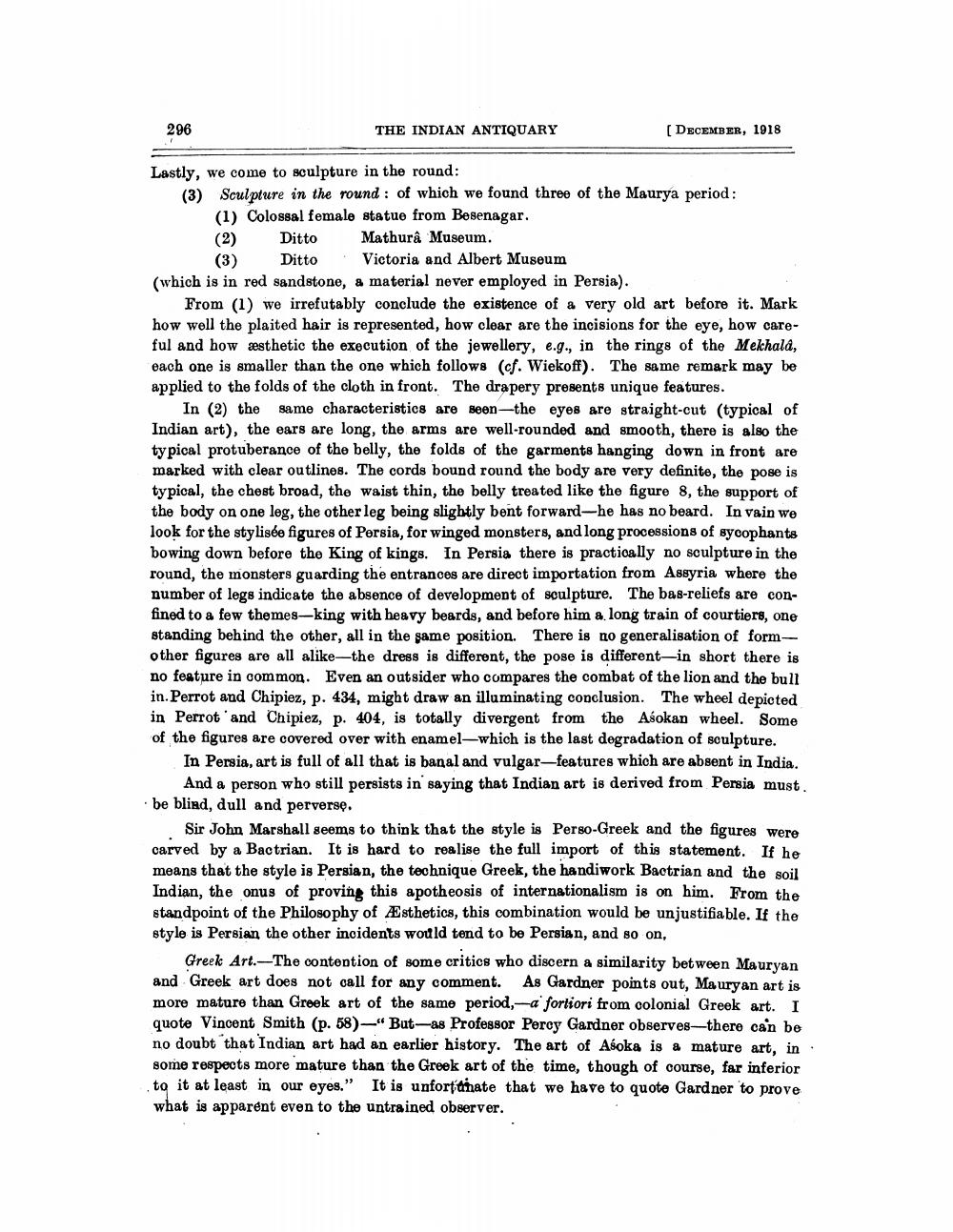________________
296
THE INDIAN ANTIQUARY
(DECEMBER, 1918
Lastly, we come to sculpture in the round: (3) Sculpture in the round : of which we found three of the Maurya period :
(1) Colossal female statue from Besenagar. (2) Ditto Mathura Museum.
(3) Ditto Victoria and Albert Museum (which is in red sandstone, a material never employed in Persia).
From (1) we irrefutably conclude the existence of a very old art before it. Mark how well the plaited hair is represented, how clear are the incisions for the eye, how careful and how aesthetic the execution of the jewellery, e.g., in the rings of the Mekhald, each one is smaller than the one which follows (cf. Wiekoff). The same remark may be applied to the folds of the cloth in front. The drapery presents unique features.
In (2) the same characteristics are seen the eyes are straight-cut (typical of Indian art), the ears are long, the arms are well-rounded and smooth, there is also the typical protuberance of the belly, the folds of the garments hanging down in front are marked with clear outlines. The cords bound round the body are very definite, the pose is typical, the chest broad, the waist thin, the belly treated like the figure 8, the support of the body on one leg, the other leg being slightly bent forward-he has no beard. In vain we look for the stylisée figures of Persia, for winged monsters, and long processions of sycophants bowing down before the King of kings. In Persia there is practically no sculpture in the round, the monsters guarding the entrances are direct importation from Assyria where the number of legs indicate the absence of development of sculpture. The bas-reliefs are confined to a few themes-king with heavy beards, and before him a long train of courtiers, one standing behind the other, all in the same position. There is no generalisation of formother figures are all alike-the dress is different, the pose is different-in short there is no feature in common. Even an outsider who compares the combat of the lion and the bull in. Perrot and Chipiez, p. 434, might draw an illuminating conclusion. The wheel depicted in Perrot' and Chipiez, p. 404, is totally divergent from the Asokan wheel. Some of the figures are covered over with enamel-which is the last degradation of sculpture.
In Persia, art is full of all that is banal and vulgar-features which are absent in India.
And a person who still persists in saying that Indian art is derived from Persia must. be blind, dull and perverse.
Sir John Marshall seems to think that the style is Perso-Greek and the figures were carved by a Bactrian. It is hard to realise the full import of this statement. If he means that the style is Persian, the technique Greek, the handiwork Bactrian and the soil Indian. the onus of provine this apotheosis of internationalism is on him. From the standpoint of the Philosophy of Æsthetics, this combination would be unjustifiable. If the style is Persian the other incidents would tend to be Persian, and so on,
Greek Art.-The contention of some critics who discern a similarity between Mauryan and Greek art does not call for any comment. As Gardner points out, Mauryan art is more mature than Greek art of the same period,-a fortiori from colonial Greek art. I quote Vincent Smith (p. 58)—"But--as Professor Peroy Gardner observes-there can be no doubt that Indian art had an earlier history. The art of Asoka is a mature art, in some respects more mature than the Greek art of the time, though of course, far inferior to it at least in our eyes." It is unfortunate that we have to quote Gardner to prove what is apparent even to the untrained observer.




